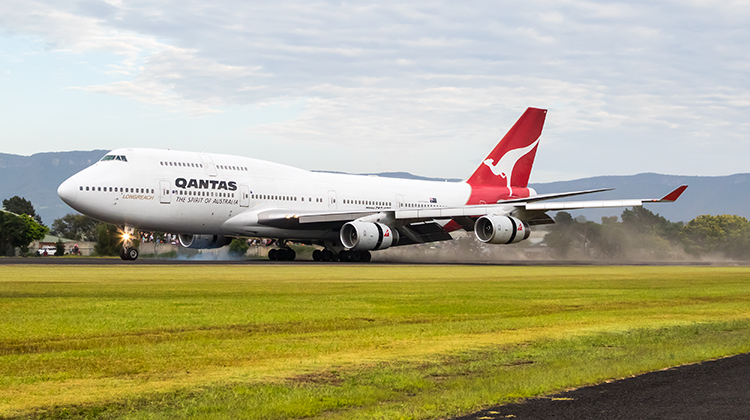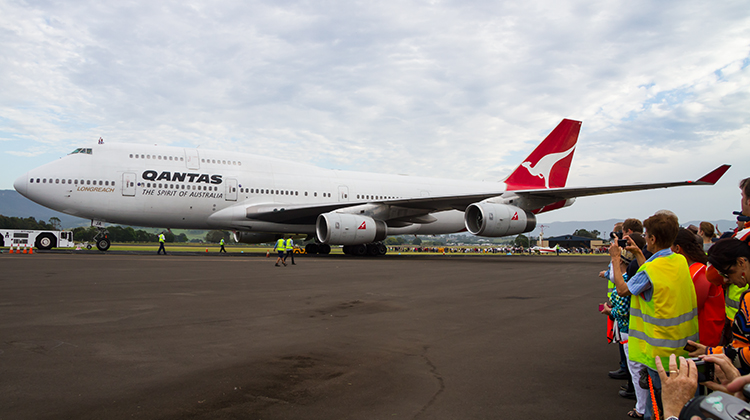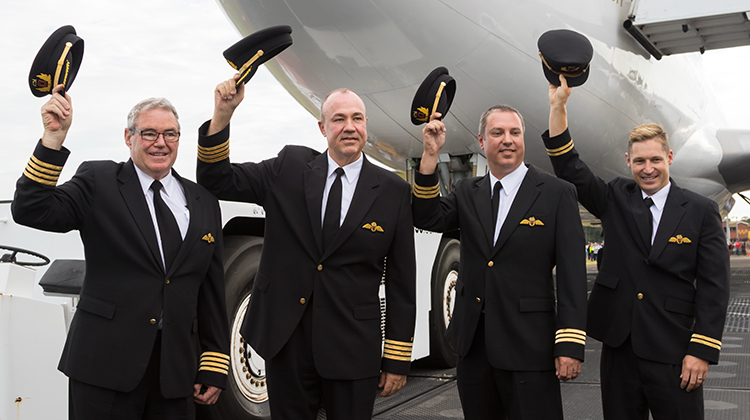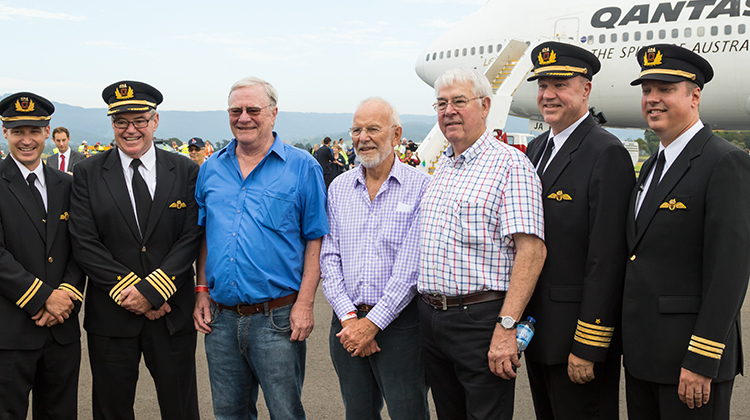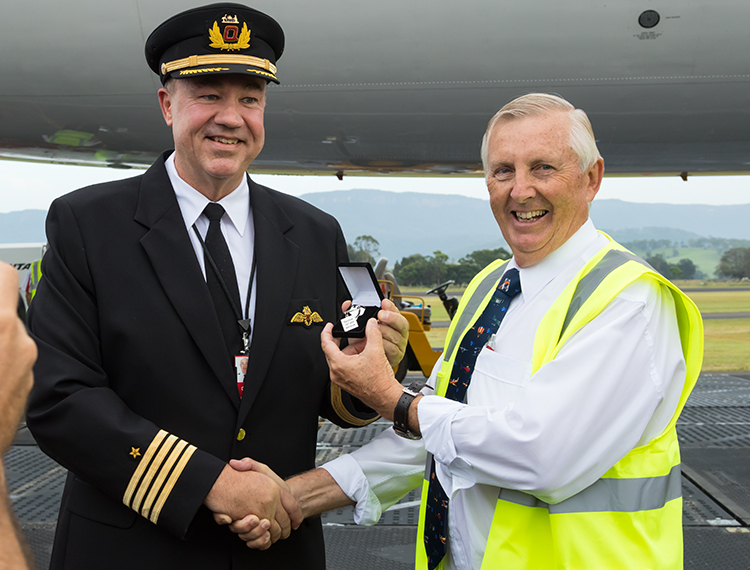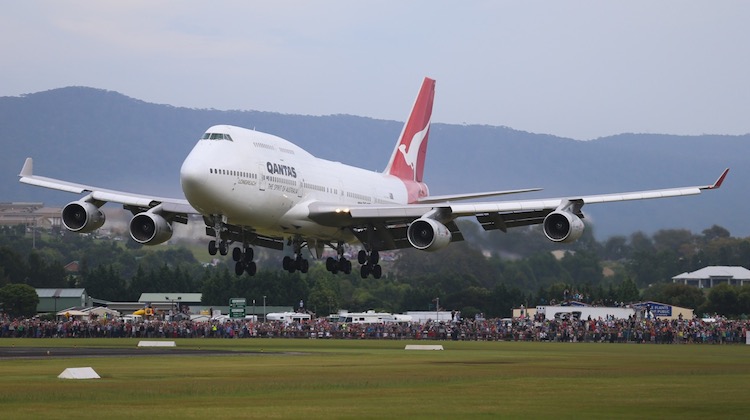
While Qantas has handed the “keys” to VH-OJA over to the Historical Aircraft Restoration Society (HARS), the record-breaking Boeing 747-400 will be surrounded by a lot of familiar faces as it settles into a new home at Illawarra Airport.
That’s because, as Qantas Captain Greg Matthews explains, there are about 400 HARS volunteers that have actually worked on the 25-year-old aircraft, the first 747-400 in the Qantas fleet.
“It forms a significant part of Qantas’s history and there are a lot of people that have an attachment to this aircraft,” Matthews told Australian Aviation after the aircraft touched down on Sunday morning.
“It is like bringing an aircraft home to them.”
The arrival of VH-OJA drew a large crowd to the airport, with some camping overnight to secure the best vantage points for the event. Roads around Albion Park were filled with cars more than an hour before the scheduled landing and mobile coffee carts were doing a roaring trade on a cool, mostly still morning with only light cloud cover.
“There was a sigh of relief this morning when we looked at the weather,” Matthews said.
“Because we had to do a visual approach in here, I was very pleased and relieved to see that the cloud base was great, the winds were light and it was shaping up to be a really nice day down here.”
Matthews, who was the pilot in command of the delivery flight, spent about 25 hours in a flight simulator to prepare for the flight alongside Sunday’s colleagues on the flightdeck Captain Ossie Miller, First Officer Peter Hagley and Second Officer Michael East.
Moreover, Matthews also got a first-hand perspective of the flying conditions at Illawarra Airport in a Piper Cherokee in the weeks prior to Sunday’s retirement flight.
The 747-400, which rolled off the Boeing’s Everett production line in 1989 and entered the record books with its non-stop London to Sydney delivery flight later that same year, pushed back from Gate seven at the Qantas domestic terminal at Sydney Airport a little after 0730 with flight number QF7474.
After a short taxi, VH-OJA lifted off into the skies for the last time off Runway 16R, as its four Rolls-Royce engines quickly took the aircraft to a cruising altitude of just above 4,000 feet and top speed of about 385 knots, according to flight tracking website Flightaware.
The crowd cheered when VH-OJA first came into view and straightened up for its five nautical mile final approach onto Illawarra Airport’s 1800m long Runway 16 and burst into applause when it landed a couple of minutes after its scheduled 0747 arrival time.
Even without using reverse thrust, the aircraft stopped with several hundred metres to spare. It then made its way to the end of the runway, where its engines were shut down and a tug attached to the front landing gear.
The aircraft was then pushed into position outside the HARS hangar, where the stairs were attached and the four-person flight crew emerged.
And just like that, VH-OJA’s flying career carrying some four million passengers about 85 million kilometres over a quarter century, was over.
It was the world’s shortest 747-400 flight at 12 minutes and 95 kilometres.
“In terms of operating into the airport here, everything worked as we expected it would,” Matthews said.
“At the end of the day it is always a sentimental time to shut down the engines on an aeroplane for the last time such as this.
“It is a great, magnificent old aeroplane but it is time for it to retire and have a rest now.
“We know it is going to be looked after by the Historical Aircraft Restoration Society.”
Among those gathered to witness a slice of aviation history outside the HARS hangar was David Massy-Greene, who was the pilot-in-command on board the record-breaking delivery flight in 1989 when VH-OJA flew for 20 hours, nine minutes and five seconds from London to Sydney.
A smiling Massy-Greene said having the 747-400 at Illawarra Airport was a fitting tribute for the aircraft given its place in Australian aviation history.
The now-retired pilot said he was relieved the initial retirement plan for the aircraft – it was understood Qantas was originally going to send VH-OJA to the desert to place it in storage or have it parted out – did not eventuate.
“The last I heard before they finally announced that it was coming here was it was going to the Mojave, which is the boneyard where they break them up,” Massy-Green said.
“My great thanks to Qantas for their generosity and my congratulations and thanks to HARS for accepting it as a permanent record of Australian aviation.
“I think it is absolutely wonderful.”
VH-OJA’s shining red tail featuring the Flying Kangaroo can be expected to gleam under the NSW South Coast’s sun for years, if not decades, to come, as Qantas has put a layer of Permaguard protector over the aircraft prior to handing it over.
Here is how photographer Seth Jaworski captured the day:
